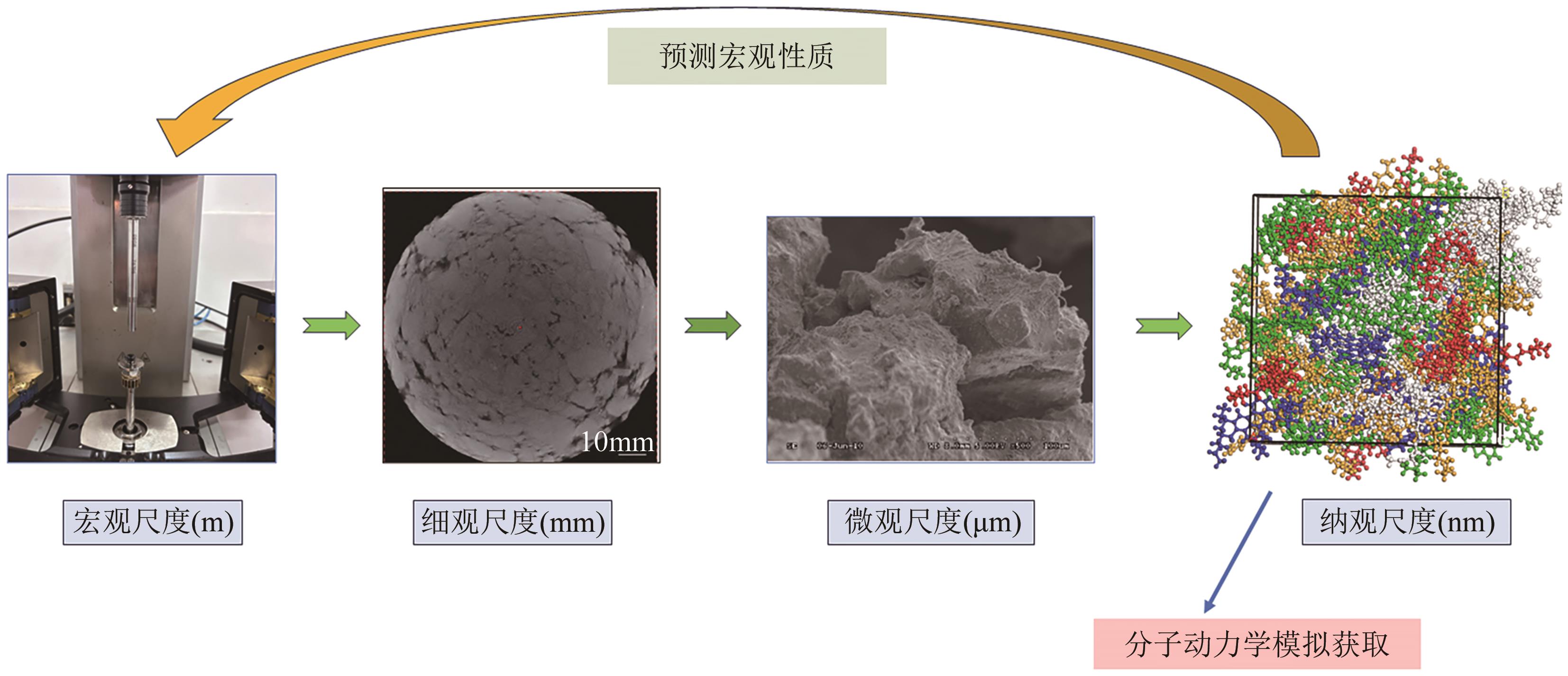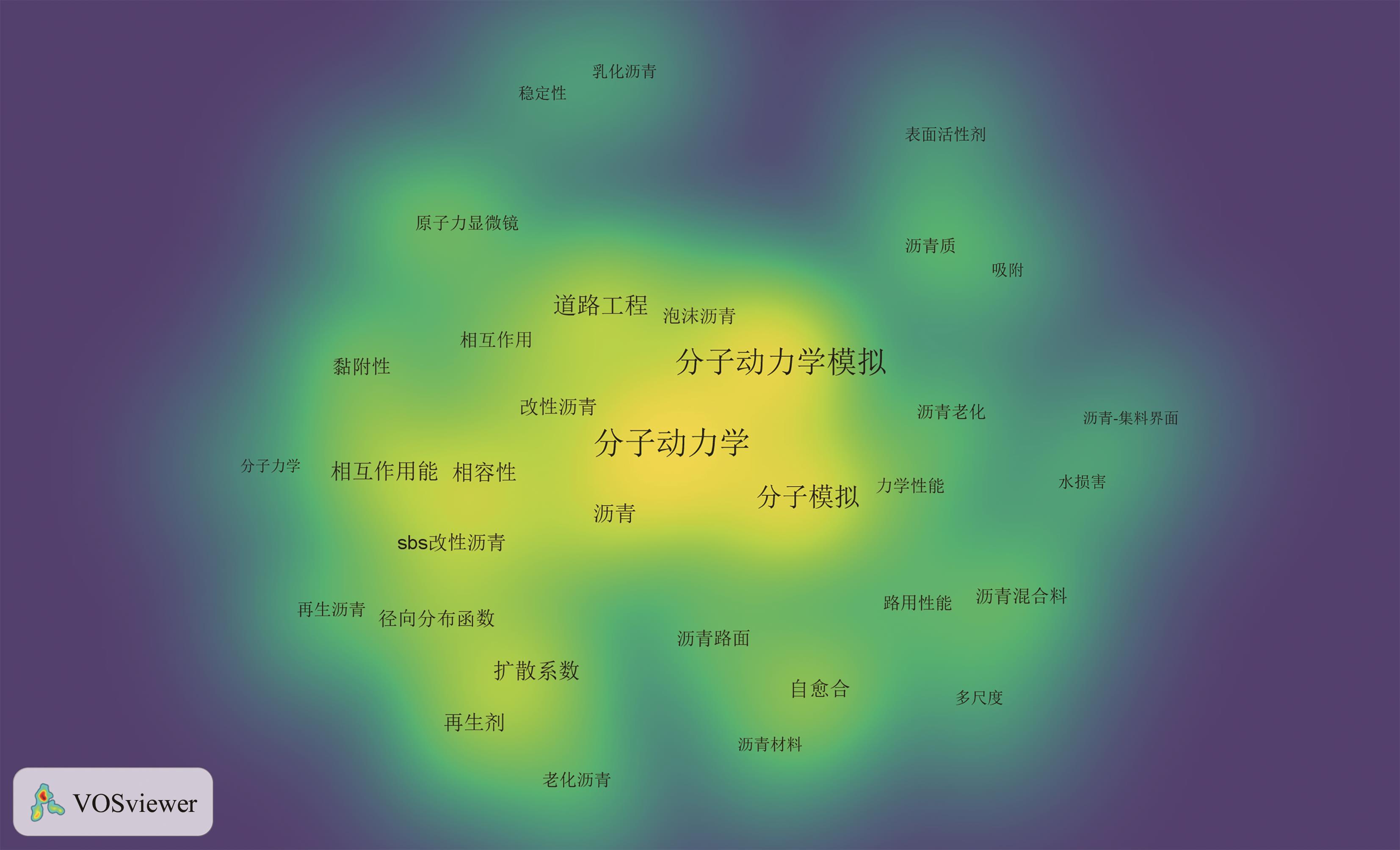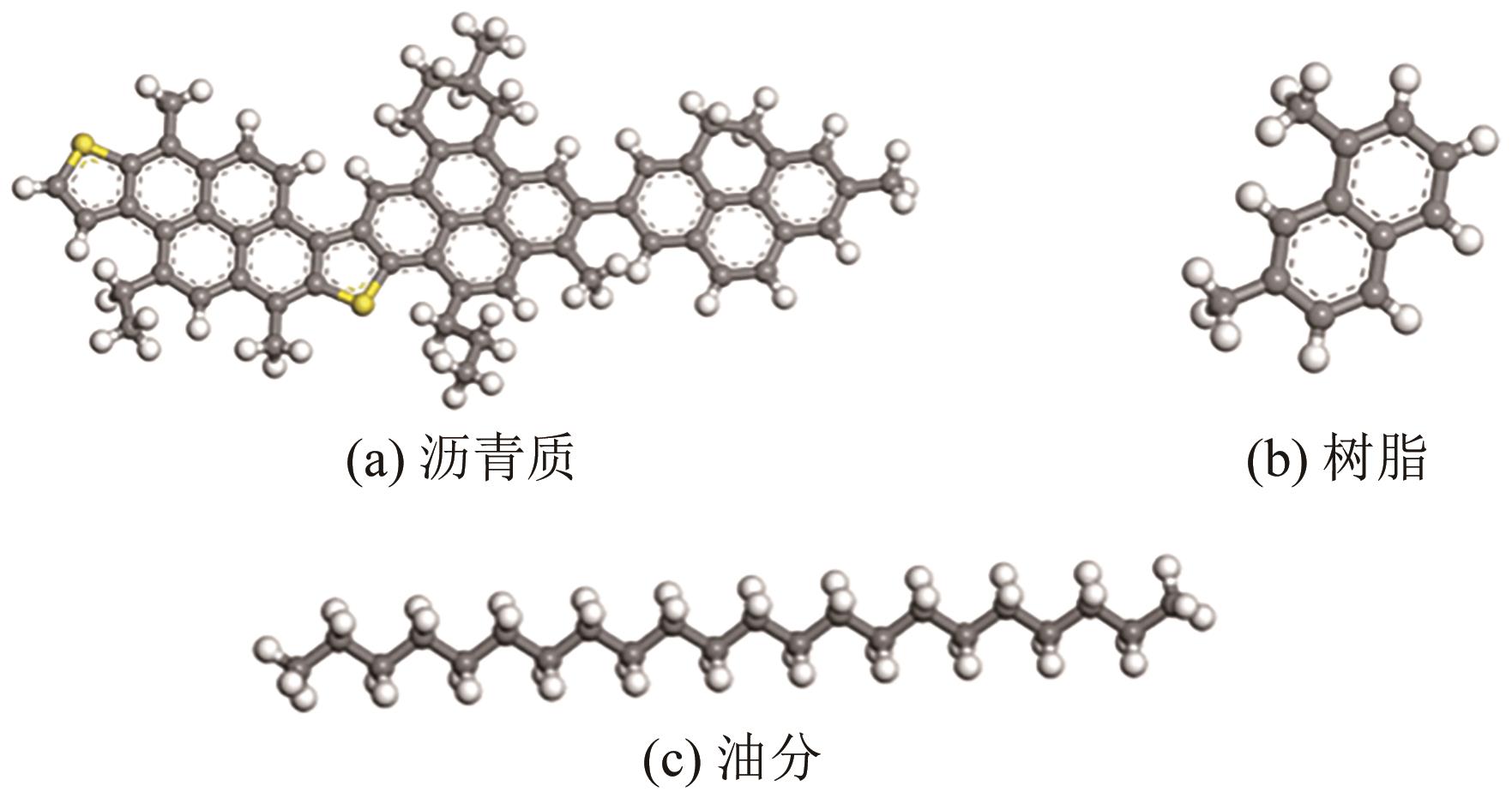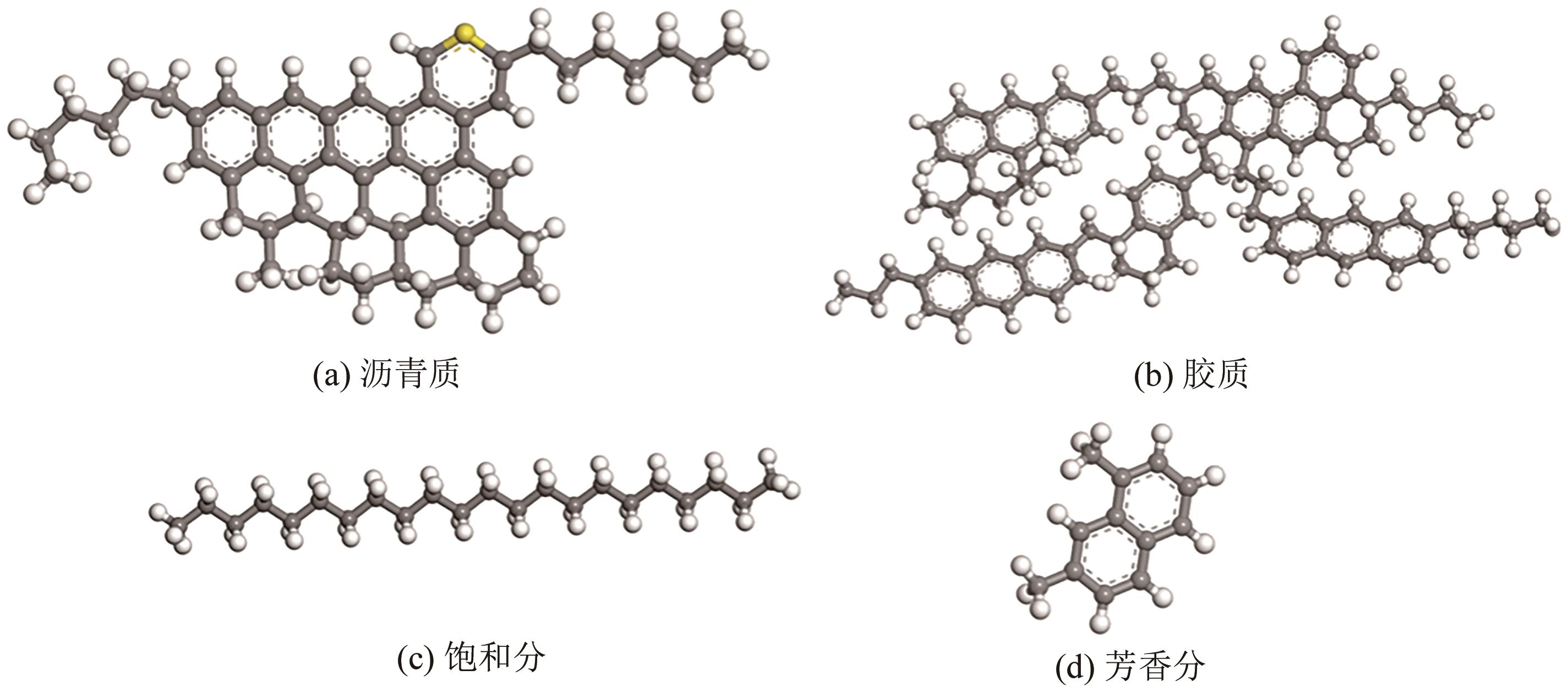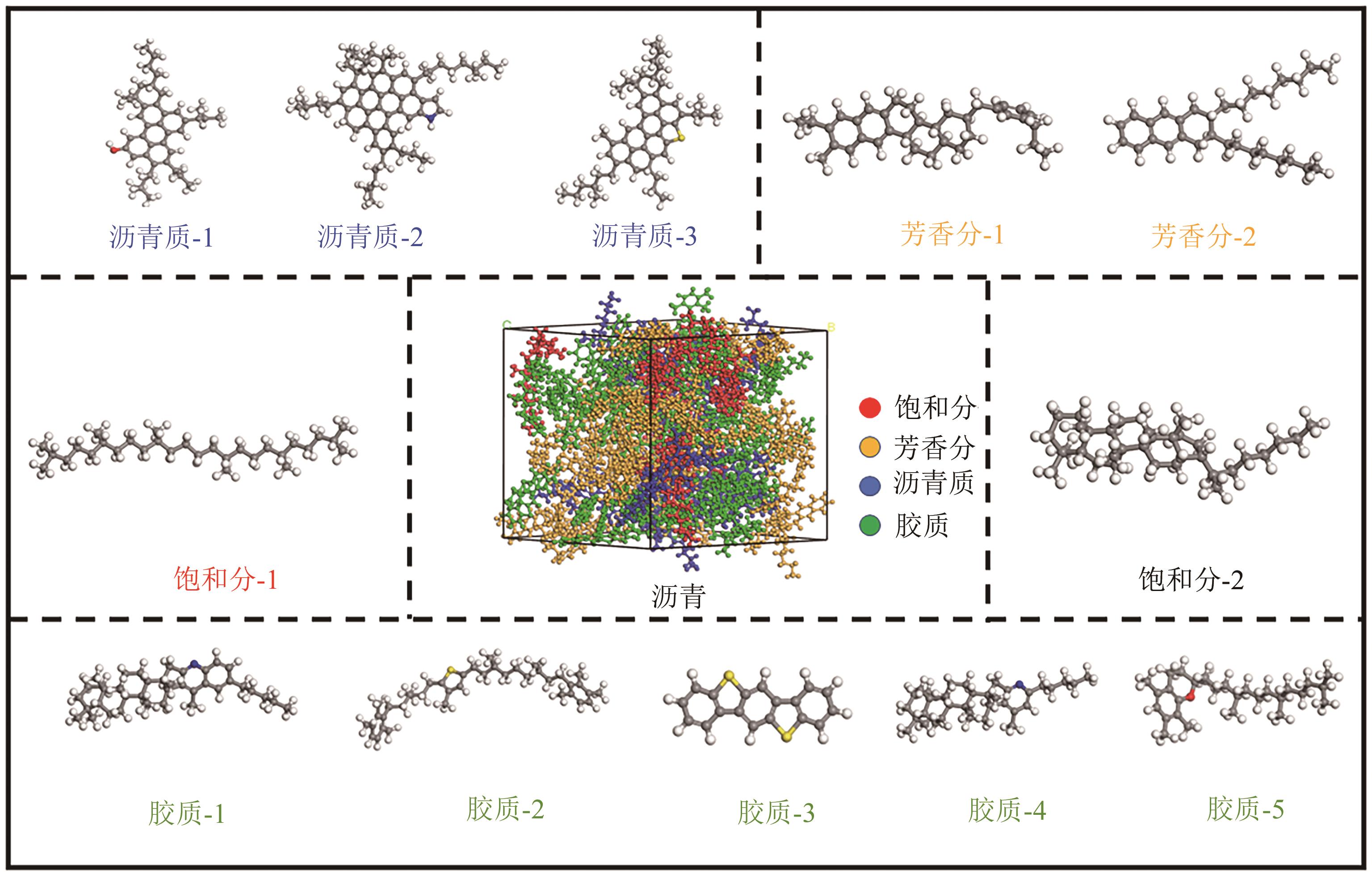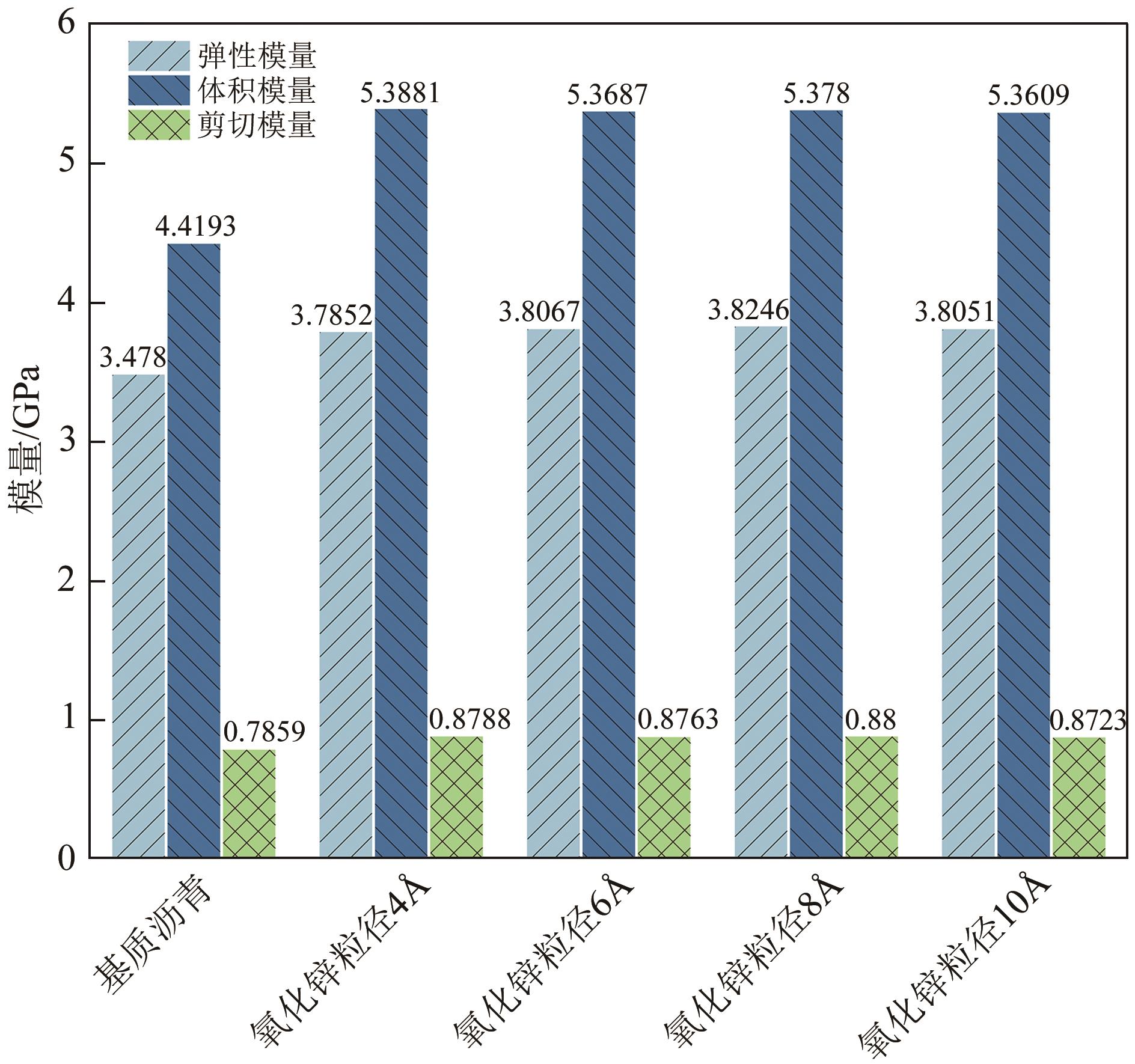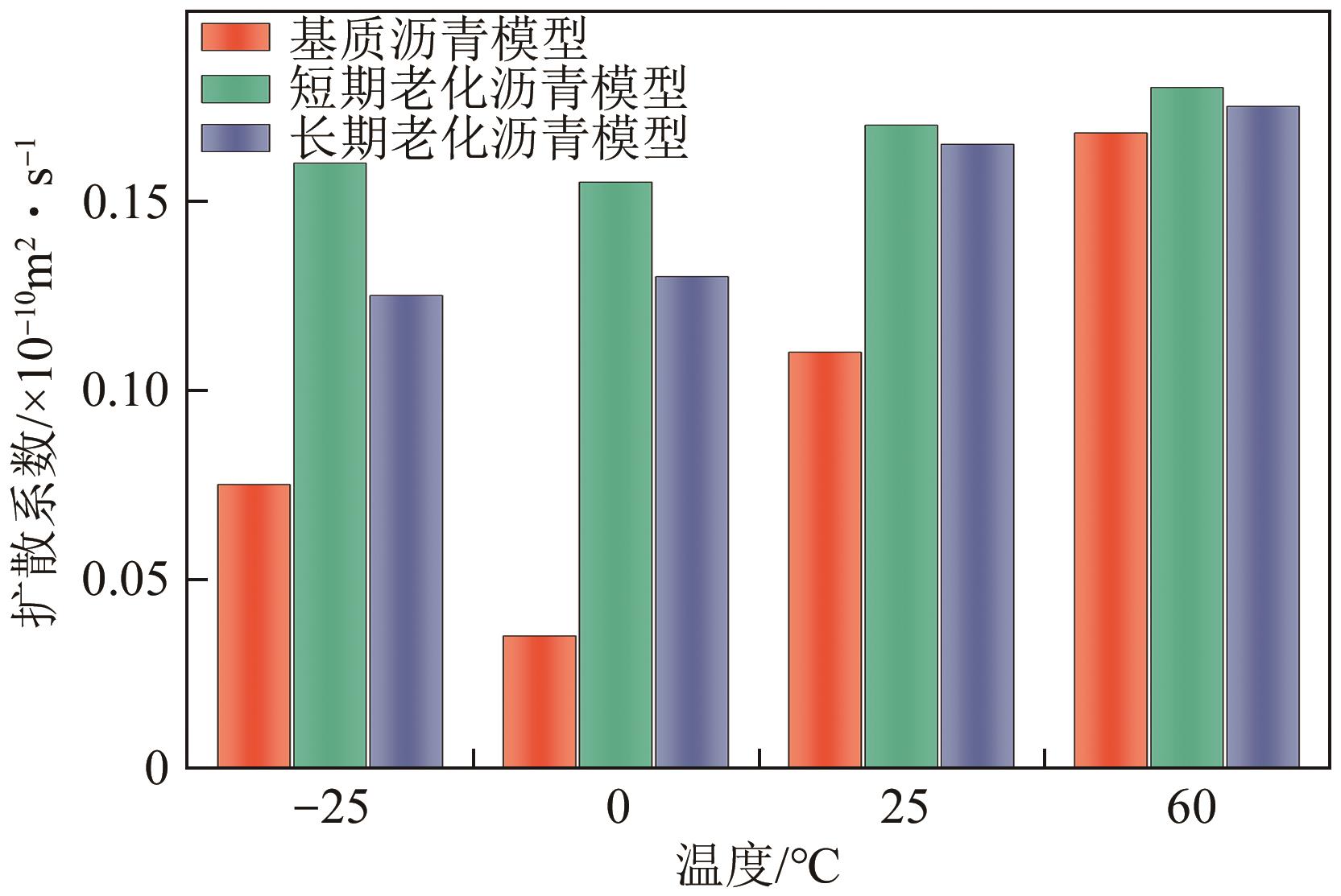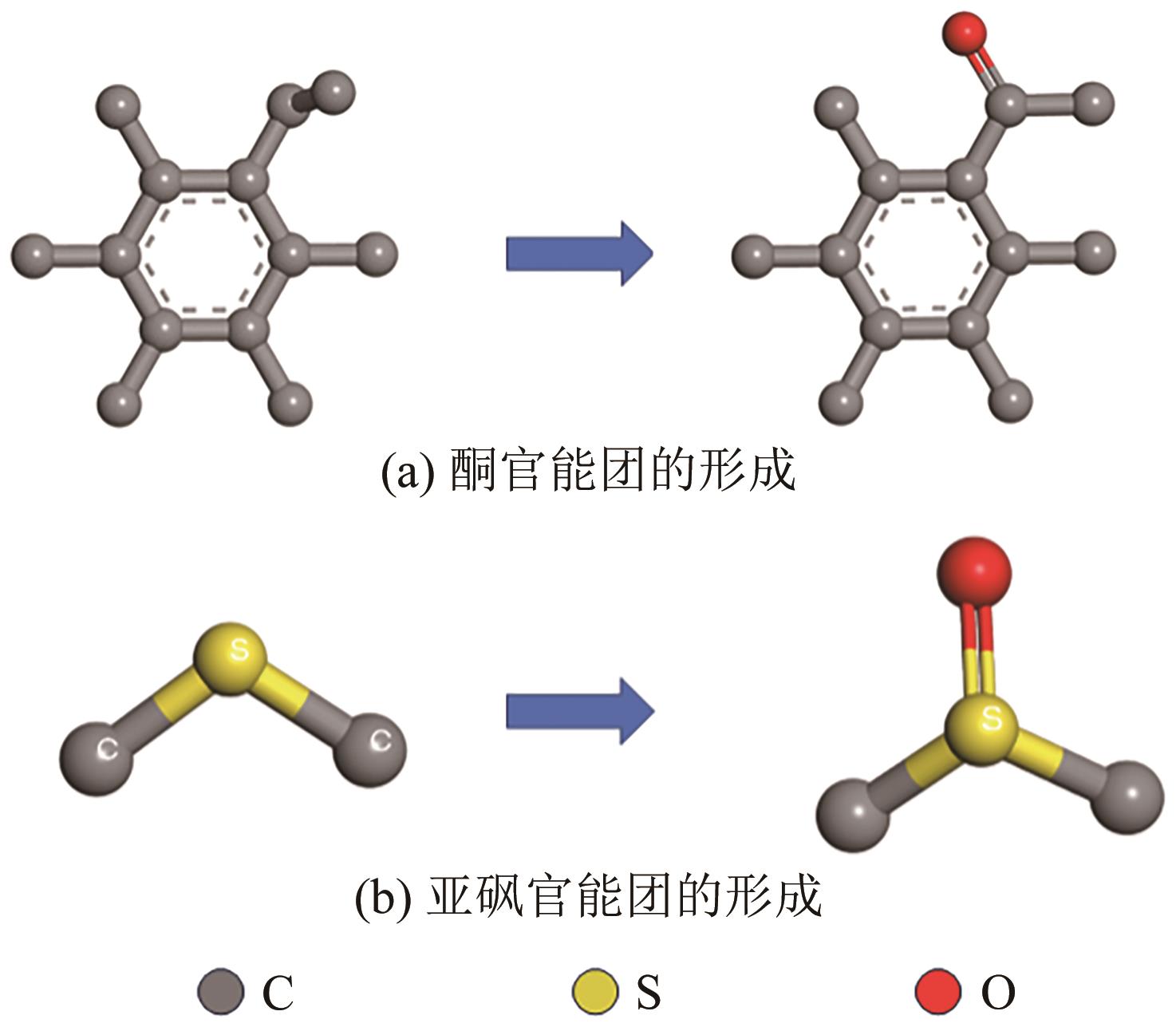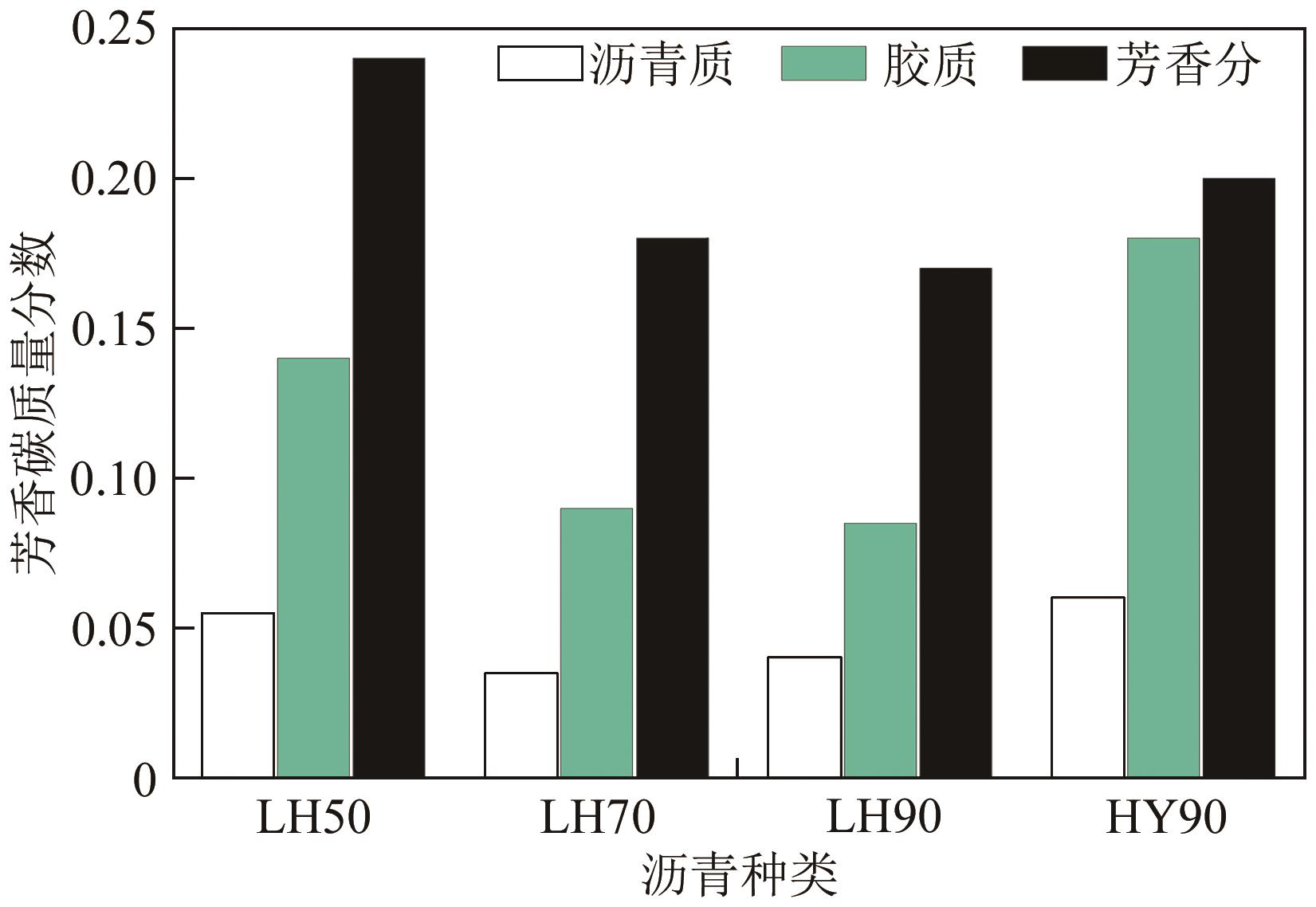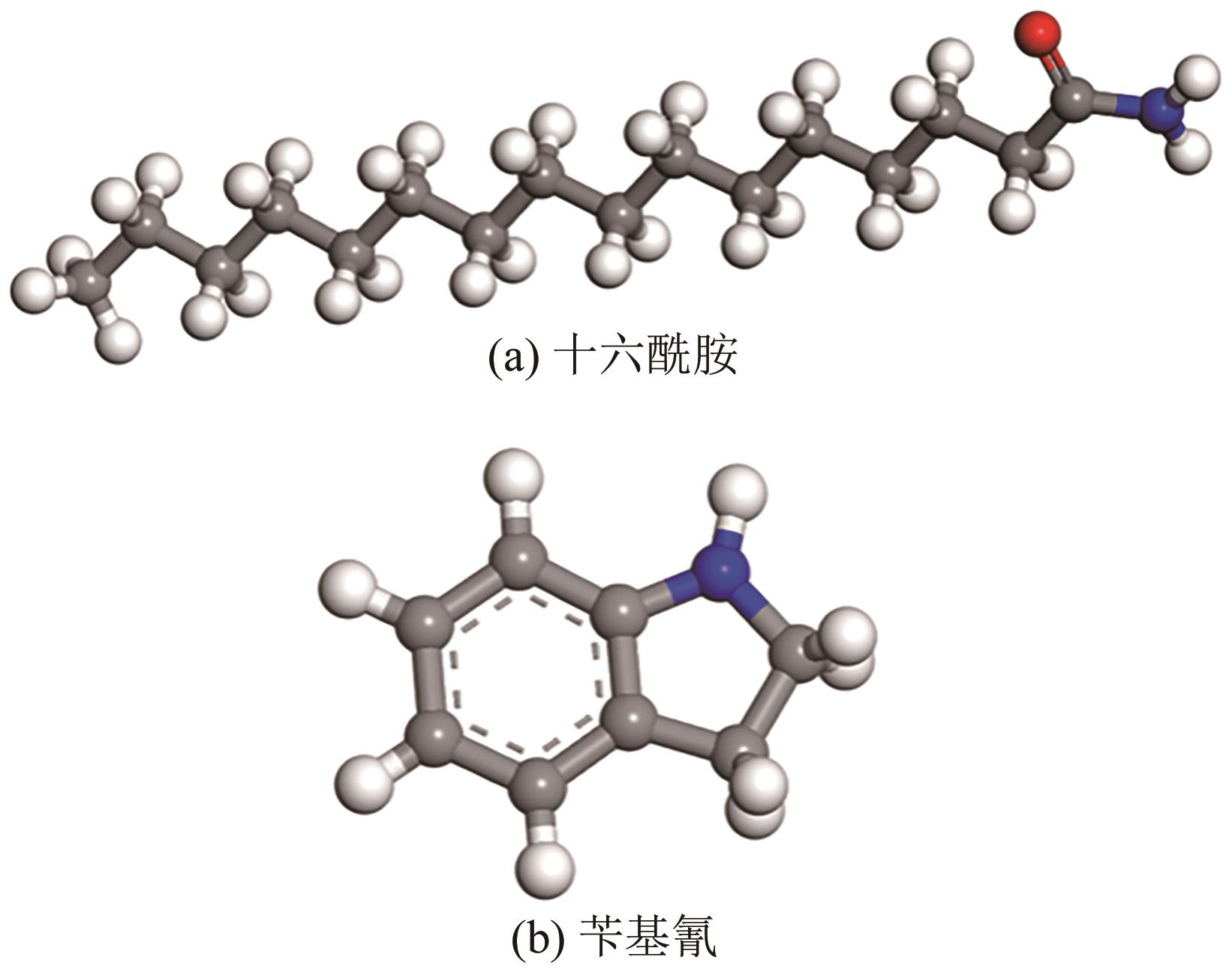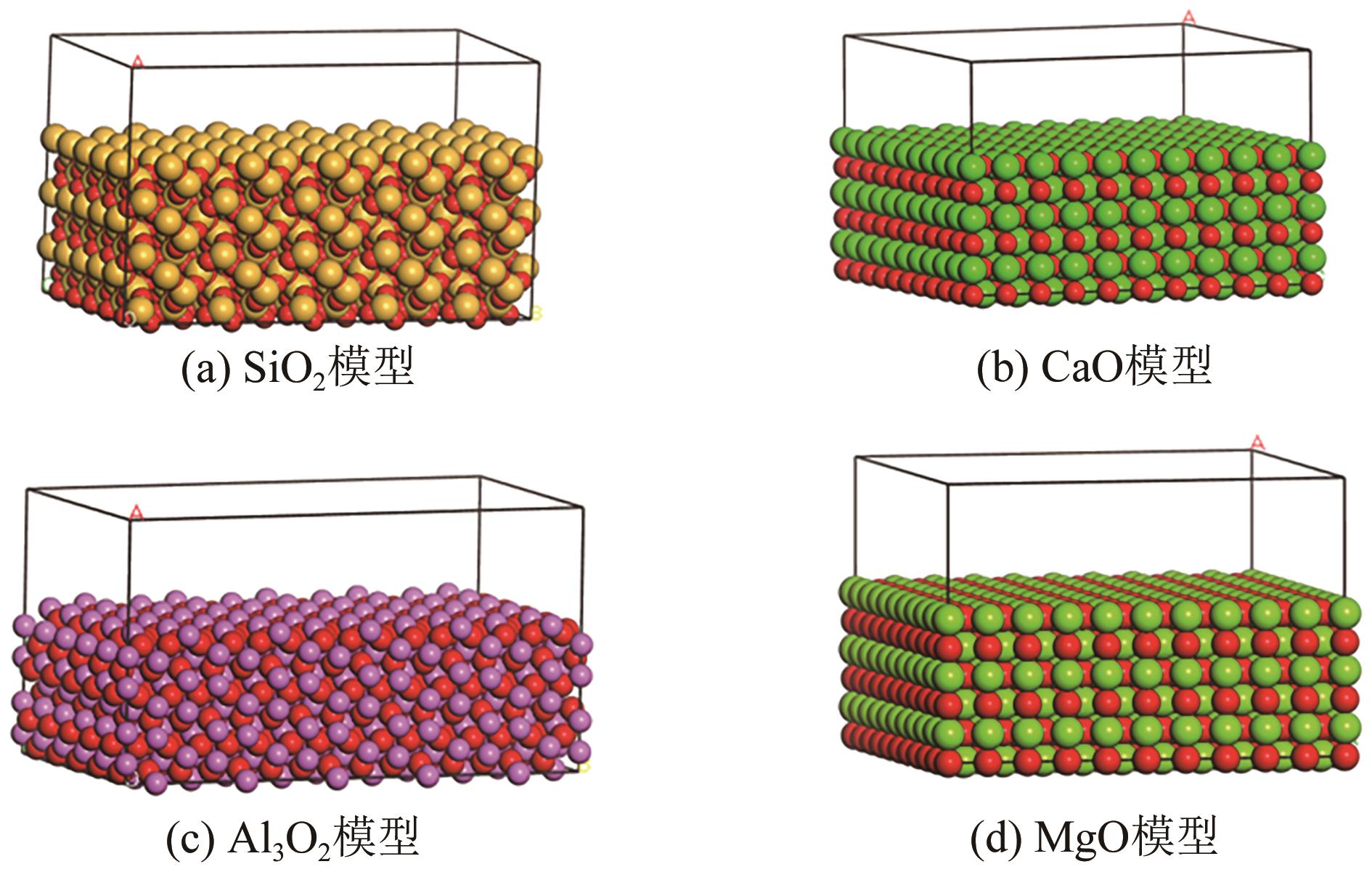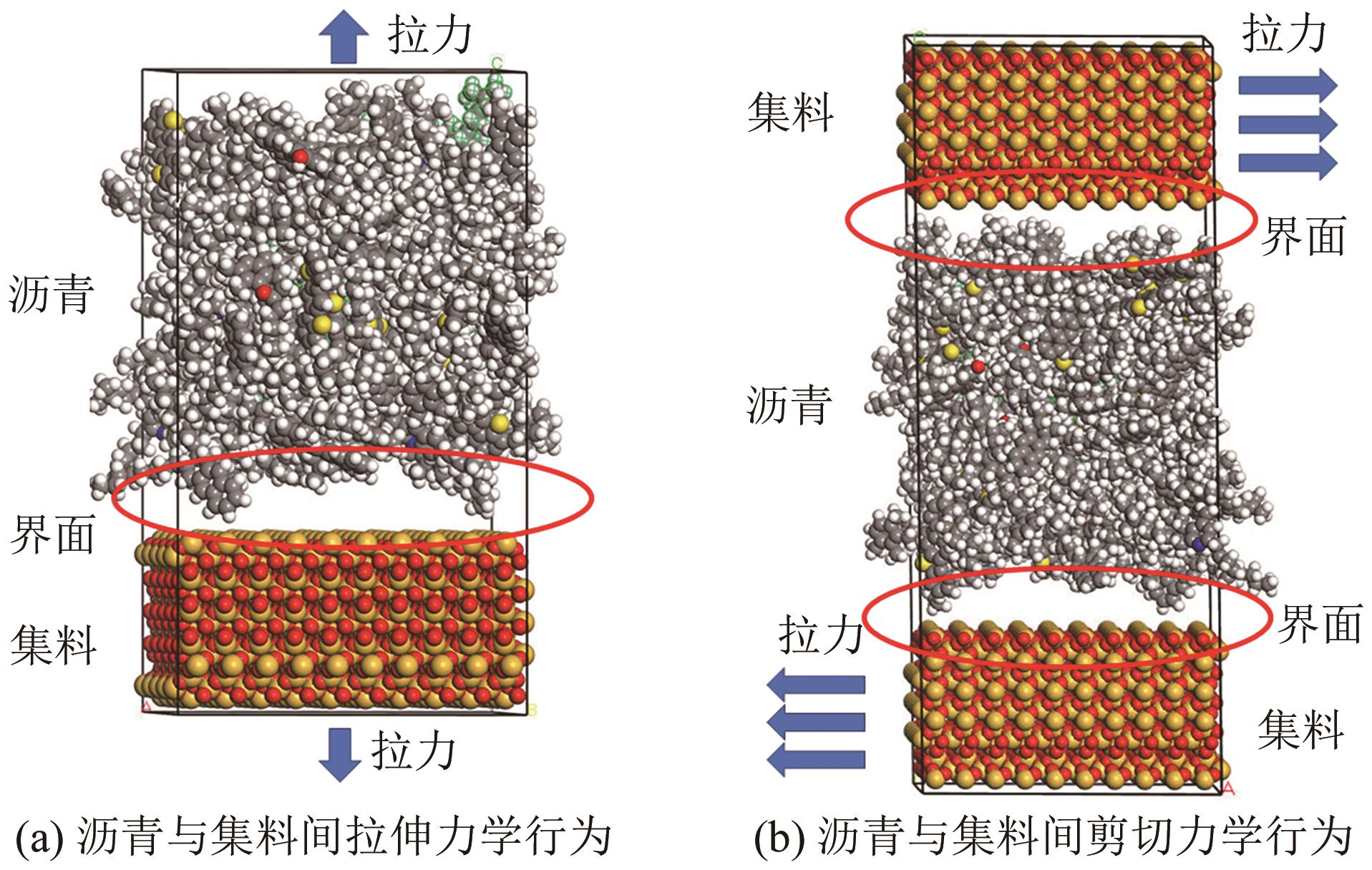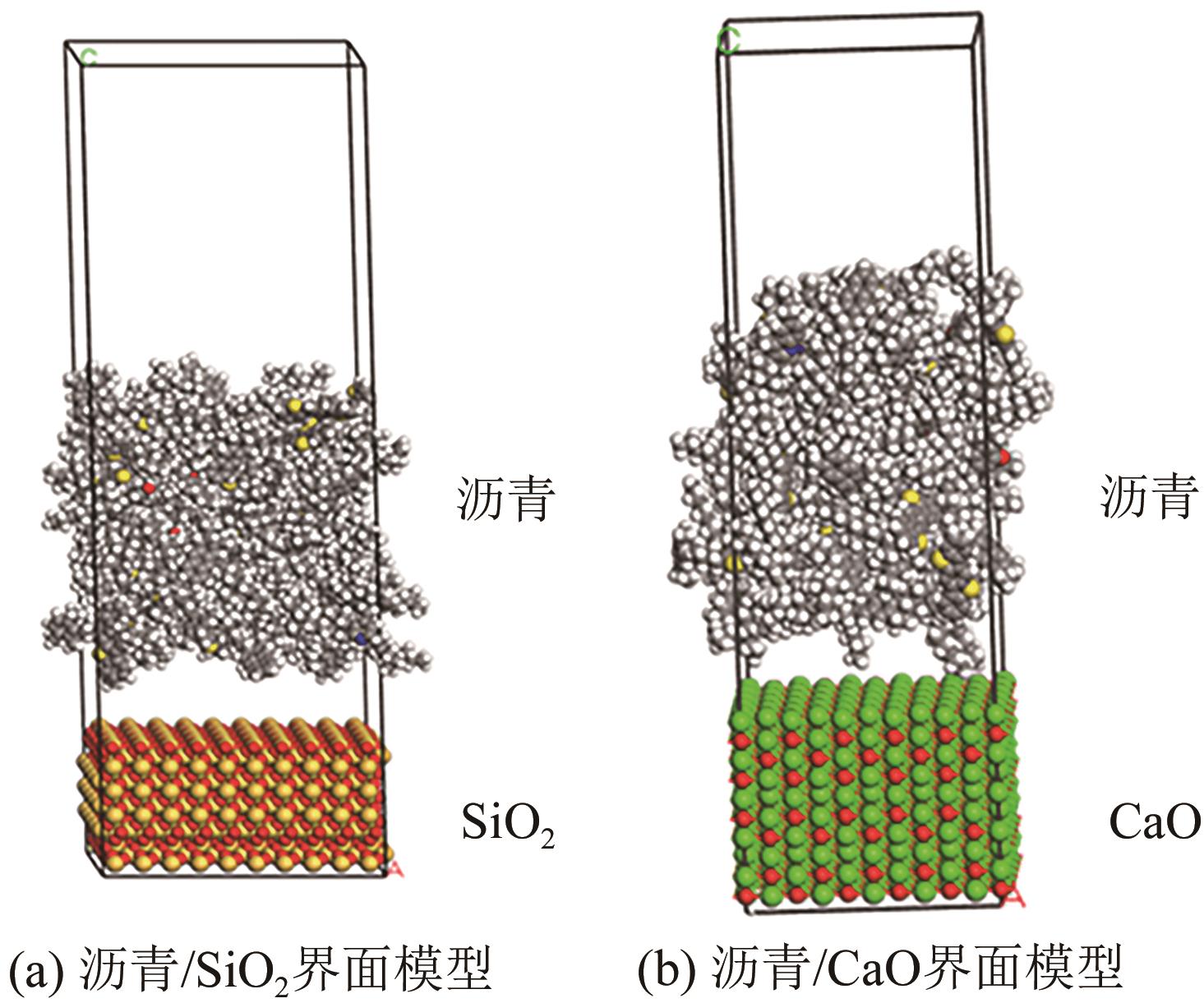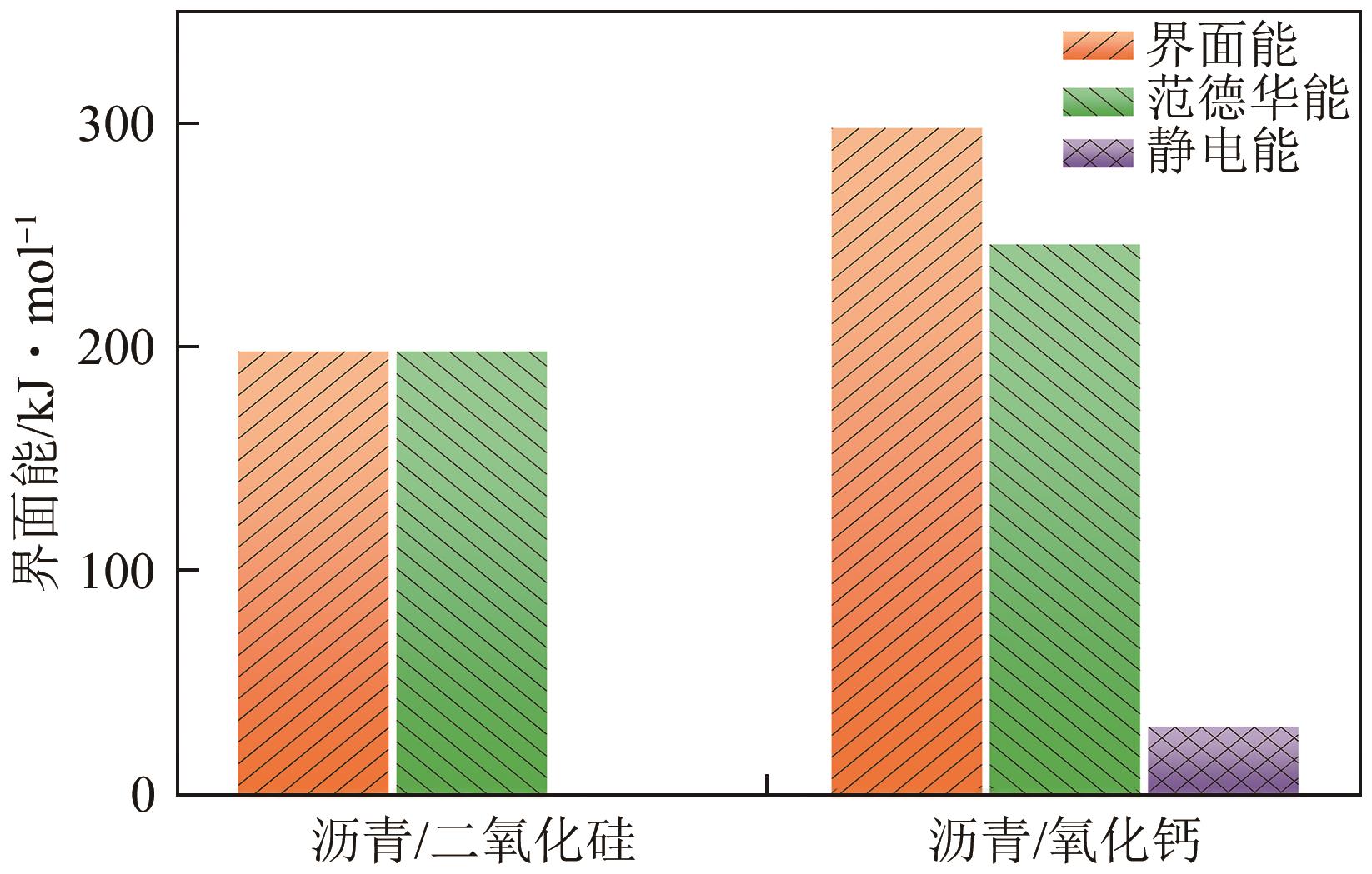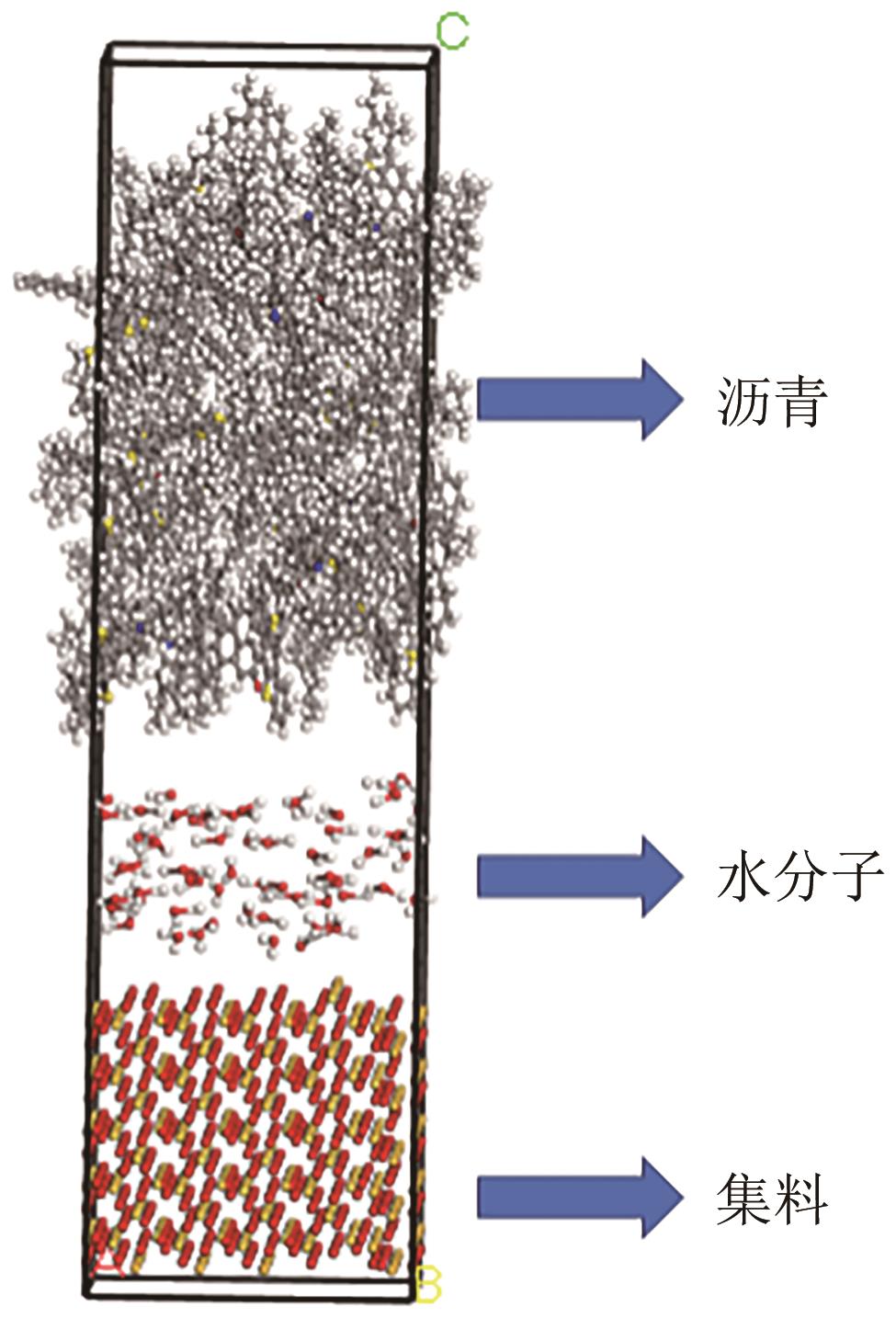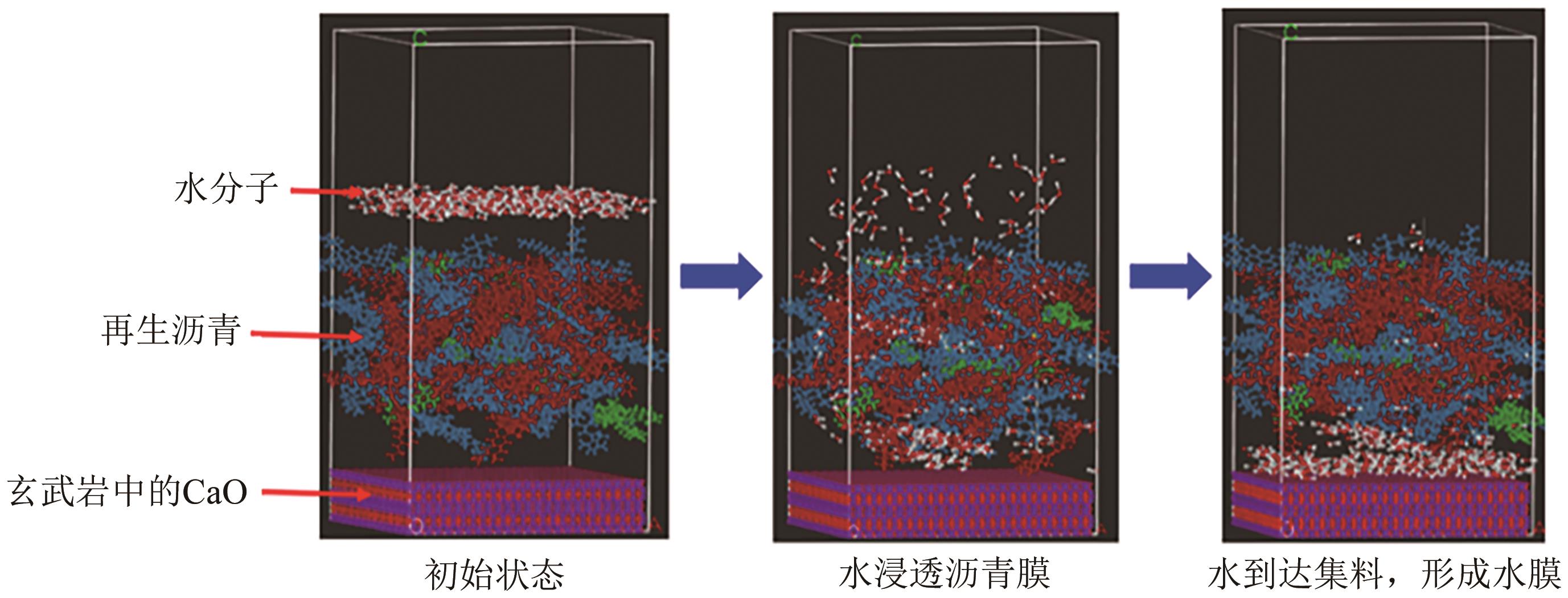化工进展 ›› 2024, Vol. 43 ›› Issue (8): 4432-4449.DOI: 10.16085/j.issn.1000-6613.2023-1235
• 材料科学与技术 • 上一篇
分子动力学模拟在沥青体系中的应用研究进展
谢娟1,2,3( ), 贺文1, 赵勖丞1, 李帅辉1, 卢真真1, 丁哲宇1
), 贺文1, 赵勖丞1, 李帅辉1, 卢真真1, 丁哲宇1
- 1.长沙理工大学交通运输工程学院,湖南 长沙 410114
2.长沙理工大学公路养护技术国家工程研究中心,湖南 长沙 410114
3.极端环境绿色长寿道路工程全国重点实验室,湖南 长沙 410114
-
收稿日期:2023-07-19修回日期:2023-10-10出版日期:2024-08-15发布日期:2024-09-02 -
通讯作者:谢娟 -
作者简介:谢娟(1981—),女,副教授,硕士生导师,研究方向为新型建筑材料、沥青与改性沥青技术。E-mail:xiejuan08@126.com。 -
基金资助:国家自然科学基金(52178411);湖南省自然科学基金(2023JJ30042);湖南省教育厅科学研究重点项目(22A0209)
Research progress on the application of molecular dynamics simulation in asphalt systems
XIE Juan1,2,3( ), HE Wen1, ZHAO Xucheng1, LI Shuaihui1, LU Zhenzhen1, DING Zheyu1
), HE Wen1, ZHAO Xucheng1, LI Shuaihui1, LU Zhenzhen1, DING Zheyu1
- 1.School of Traffic and Transportation Engineering, Changsha University of Science and Technology, Changsha 410114, Hunan, China
2.National Engineering Research Center of Highway Maintenance Technology, Changsha University of Science and Technology, Changsha 410114, Hunan, China
3.National Key Laboratory of Green and Long-Life Road Engineering in Extreme Environment, Changsha 410114, Hunan, China
-
Received:2023-07-19Revised:2023-10-10Online:2024-08-15Published:2024-09-02 -
Contact:XIE Juan
摘要:
随着计算机技术的飞速发展,分子模拟方法已被广泛应用于各个领域。本文总结了沥青分子模型、老化沥青模型、集料模型的构建方法以及基质沥青模型的验证方法。通过分子动力学(MD)模拟,探讨了沥青的性质与性能、沥青的扩散现象、改性剂对沥青的改性作用、沥青老化与再生以及沥青与集料的界面相互作用。MD模拟方法能够预测沥青材料的性能,包括基质沥青的力学性能、低温性能、抗老化性能、自愈合性能,基质沥青与改性剂的相容性以及沥青与集料界面的力学性能、黏附性等性能,架起了宏观和微观行为之间的桥梁,为MD模拟在沥青材料的广泛应用提供了指导。但MD模拟在沥青体系中还需要进一步完善,如初始模型的建立、力场的优化和模型验证等,目前分子动力学模拟只关注沥青材料与改性剂之间的物理作用,缺少对两者之间化学作用的研究。此外,分子动力学在沥青混合料中的应用目前只限于沥青与集料界面之间的研究。最后,对MD模拟在沥青体系中的未来发展方向进行了展望,在未来需要使用MD方法来研究沥青的高温流变性能、沥青与改性剂的界面模拟以及多种改性剂与沥青之间的相互作用。此外,还需要探究多种因素(如裂缝宽度、改性剂、温度和再生剂)共同作用下对沥青自愈合性能的影响,为了探究沥青与改性剂之间的化学相互作用,建议结合量子力学等其他模拟方法进行研究,在沥青混合料方面建议结合有限元等模拟方法来研究沥青混合料的性能。
中图分类号:
引用本文
谢娟, 贺文, 赵勖丞, 李帅辉, 卢真真, 丁哲宇. 分子动力学模拟在沥青体系中的应用研究进展[J]. 化工进展, 2024, 43(8): 4432-4449.
XIE Juan, HE Wen, ZHAO Xucheng, LI Shuaihui, LU Zhenzhen, DING Zheyu. Research progress on the application of molecular dynamics simulation in asphalt systems[J]. Chemical Industry and Engineering Progress, 2024, 43(8): 4432-4449.
| 沥青 四组分 | 分子 | 分子 化学式 | 分子量 /g·mol-1 | 分子数 | ||
|---|---|---|---|---|---|---|
| AAA-1 | AAK-1 | AAM-1 | ||||
| 沥青质 | As-1 | C42H54O | 574.893 | 3 | 3 | 1 |
| As-2 | C66H81N | 888.381 | 2 | 2 | 1 | |
| As-3 | C51H62S | 707.117 | 3 | 3 | 1 | |
| 饱和分 | Sa-1 | C30H62 | 422.826 | 4 | 2 | 1 |
| Sa-2 | C35H62 | 482.881 | 4 | 2 | 1 | |
| 芳香分 | Ar-1 | C35H44 | 464.737 | 11 | 10 | 20 |
| Ar-2 | C30H46 | 406.698 | 13 | 10 | 21 | |
| 胶质 | Re-1 | C40H59N | 553.919 | 4 | 4 | 10 |
| Re-2 | C40H60S | 572.980 | 4 | 4 | 10 | |
| Re-3 | C18H10S2 | 290.398 | 15 | 12 | 4 | |
| Re-4 | C36H57N | 503.859 | 4 | 4 | 10 | |
| Re-5 | C29H50O | 414.718 | 5 | 4 | 10 | |
表1 AAA-1、AAK-1和AAM-1基质沥青模型[11]
| 沥青 四组分 | 分子 | 分子 化学式 | 分子量 /g·mol-1 | 分子数 | ||
|---|---|---|---|---|---|---|
| AAA-1 | AAK-1 | AAM-1 | ||||
| 沥青质 | As-1 | C42H54O | 574.893 | 3 | 3 | 1 |
| As-2 | C66H81N | 888.381 | 2 | 2 | 1 | |
| As-3 | C51H62S | 707.117 | 3 | 3 | 1 | |
| 饱和分 | Sa-1 | C30H62 | 422.826 | 4 | 2 | 1 |
| Sa-2 | C35H62 | 482.881 | 4 | 2 | 1 | |
| 芳香分 | Ar-1 | C35H44 | 464.737 | 11 | 10 | 20 |
| Ar-2 | C30H46 | 406.698 | 13 | 10 | 21 | |
| 胶质 | Re-1 | C40H59N | 553.919 | 4 | 4 | 10 |
| Re-2 | C40H60S | 572.980 | 4 | 4 | 10 | |
| Re-3 | C18H10S2 | 290.398 | 15 | 12 | 4 | |
| Re-4 | C36H57N | 503.859 | 4 | 4 | 10 | |
| Re-5 | C29H50O | 414.718 | 5 | 4 | 10 | |
| 沥青 | 老化 时间/h | 内聚能密度 /J·mol-3 | 弹性 模量E/GPa | 体积 模量K/GPa | 剪切 模量G/GPa |
|---|---|---|---|---|---|
| 基质沥青 | 0 | 322.3 | 2.478 | 4.419 | 0.776 |
| 12 | 386.5 | 3.879 | 5.639 | 0.897 | |
| 改性沥青 | 0 | 432.6 | 3.909 | 6.087 | 1.032 |
| 12 | 486.3 | 4.901 | 6.897 | 1.111 |
表2 基质沥青及改性沥青紫外老化前后的内聚能密度及力学参数[72]
| 沥青 | 老化 时间/h | 内聚能密度 /J·mol-3 | 弹性 模量E/GPa | 体积 模量K/GPa | 剪切 模量G/GPa |
|---|---|---|---|---|---|
| 基质沥青 | 0 | 322.3 | 2.478 | 4.419 | 0.776 |
| 12 | 386.5 | 3.879 | 5.639 | 0.897 | |
| 改性沥青 | 0 | 432.6 | 3.909 | 6.087 | 1.032 |
| 12 | 486.3 | 4.901 | 6.897 | 1.111 |
| 1 | 裴建新.沥青裂缝自修复微胶囊的制备与表征[J]. 化工进展,2016, 35(9): 2898-2904. |
| PEI Jianxin. Preparation and properties of self-healing microcapsule for asphalt crack[J]. Chemical Industry and Engineering Progress, 2016, 35(9): 2898-2904. | |
| 2 | 方伟锋, 沈本贤, 仝玉军, 等. LM-S沥青改性剂提高沥青混合料黏附性能的分子模拟计算及路用性能考察[J]. 化工进展,2018,37(10):3949-3957. |
| FANG Weifeng, SHEN Benxian, TONG Yujun, et al. Molecular simulation of LM-S asphalt modifier to improve the adhesion of asphalt mixture and investigation of road performance[J]. Chemical Industry and Engineering Progress, 2018, 37(10): 3949-3957. | |
| 3 | 谭利鹏, 申峻, 王玉高, 等. 煤沥青和石油沥青共混改性的研究进展[J]. 化工进展, 2023, 42(7): 3749-3759. |
| TAN Lipeng, SHEN Jun, WANG Yugao, et al. Research progress on blending modification of coal tar pitch and petroleum asphalt[J]. Chemical Industry and Engineering Progress, 2023, 42(7): 3749-3759. | |
| 4 | LU Pengzhen, MA Yiheng, YE Kai, et al. Analysis of high-temperature performance of polymer-modified asphalts through molecular dynamics simulations and experiments[J]. Construction and Building Materials, 2022, 350: 128903. |
| 5 | 谭忆秋, 李冠男, 单丽岩, 等. 沥青微观结构组成研究进展[J]. 交通运输工程学报, 2020, 20(6): 1-17. |
| TAN Yiqiu, LI Guannan, SHAN Liyan, et al. Research progress of bitumen microstructures and components[J]. Journal of Traffic and Transportation Engineering, 2020, 20(6): 1-17. | |
| 6 | CHEN Zixuan, PEI Jianzhong, LI Rui, et al. Performance characteristics of asphalt materials based on molecular dynamics simulation—A review[J]. Construction and Building Materials, 2018, 189: 695-710. |
| 7 | 郭鹏坤, 李攀, 常春, 等. 计算机模拟技术在生物质转化中的应用研究进展[J]. 化工进展, 2020, 39(8): 3027-3040. |
| GUO Pengkun, LI Pan, CHANG Chun, et al. Advances in the application of computer simulation technology in biomass conversion[J]. Chemical Industry and Engineering Progress, 2020, 39(8): 3027-3040. | |
| 8 | 李光升, 解强, 张香兰, 等. 基于分子模拟的低温煤焦油中酚类化合物的溶解特性[J]. 化工进展, 2020, 39(1): 137-144. |
| LI Guangsheng, XIE Qiang, ZHANG Xianglan, et al. Solubility of phenolic compounds in low temperature coal tar based on molecular simulation[J]. Chemical Industry and Engineering Progress, 2020, 39(1): 137-144. | |
| 9 | 唐伯明, 丁勇杰, 朱洪洲, 等. 沥青分子聚集状态变化特征研究[J]. 中国公路学报, 2013, 26(3): 50-56, 76. |
| TANG Boming, DING Yongjie, ZHU Hongzhou, et al. Study on agglomeration variation pattern of asphalt molecules[J]. China Journal of Highway and Transport, 2013, 26(3): 50-56, 76. | |
| 10 | 曹丽萍, 张晓亢, 杨晨, 等. 基于分子动力学的硅烷偶联剂对铁尾矿沥青混合料改性的机理[J]. 中南大学学报(自然科学版), 2021, 52(7): 2276-2286. |
| CAO Liping, ZHANG Xiaokang, YANG Chen, et al. Modification mechanism of iron tailings asphalt mixture by silane coupling agents based on molecular dynamics[J]. Journal of Central South University (Science and Technology), 2021, 52(7): 2276-2286. | |
| 11 | LI Derek D, GREENFIELD Michael L. Chemical compositions of improved model asphalt systems for molecular simulations[J]. Fuel, 2014, 115: 347-356. |
| 12 | 郑仕跃, 邹卓民, 周权峰, 等. 基于12成分模型和分子动力学的沥青材料性质模拟研究[J]. 铁道科学与工程学报, 2022, 19(5): 1331-1338. |
| ZHENG Shiyue, ZOU Zhuomin, ZHOU Quanfeng, et al. Simulation of asphalt properties based on 12-component model and molecular dynamics[J]. Journal of Railway Science and Engineering, 2022, 19(5): 1331-1338. | |
| 13 | XU Meng, YI Junyan, QI Pei, et al. Improved chemical system for molecular simulations of asphalt[J]. Energy & Fuels, 2019, 33(4): 3187-3198. |
| 14 | ARTOK Levent, SU Yan, HIROSE Yoshihisa, et al. Structure and reactivity of petroleum-derived asphaltene[J]. Energy & Fuels, 1999, 13(2): 287-296. |
| 15 | 栗启, 胡魁, 俞才华, 等. 聚乙烯与沥青相互作用的分子动力学机理研究[J]. 材料导报, 2023, 37(5): 268-273. |
| LI Qi, HU Kui, YU Caihua, et al. Molecular dynamics mechanism study of the interaction between polyethylene and asphalt[J]. Materials Reports, 2023, 37(5): 268-273. | |
| 16 | 苏曼曼, 司春棣, 张洪亮. 纳米ZnO改性沥青分子动力学模拟研究[J]. 重庆交通大学学报(自然科学版), 2021, 40(11): 118-127. |
| SU Manman, SI Chundi, ZHANG Hongliang. Molecular dynamics simulation of nano-ZnO modified asphalt[J]. Journal of Chongqing Jiaotong University (Natural Science), 2021, 40(11): 118-127. | |
| 17 | 王岚, 张乐, 刘旸. 老化前后沥青与胶粉相容性的分子动力学研究[J]. 建筑材料学报, 2019, 22(3): 474-479. |
| WANG Lan, ZHANG Le, LIU Yang. Molecular dynamics study on compatibility of asphalt and rubber powders before and after aging[J]. Journal of Building Materials, 2019, 22(3): 474-479. | |
| 18 | HUANG Ting, ZHANG Zengping, WANG Li, et al. Study on the compatibility between polyurethane and asphalt based on experiment and molecular dynamics simulation[J]. Case Studies in Construction Materials, 2022, 17: e01424. |
| 19 | 崔亚楠, 李雪杉, 张淑艳. 基于分子动力学模拟的再生剂-老化沥青扩散机理[J]. 建筑材料学报, 2021, 24(5): 1105-1109. |
| CUI Yanan, LI Xueshan, ZHANG Shuyan. Diffusion mechanism of regenerant aged asphalt based on molecular dynamics simulation[J]. Journal of Building Materials, 2021, 24(5): 1105-1109. | |
| 20 | 朱建勇. 沥青胶结料自愈合行为的分子动力学模拟[J]. 建筑材料学报, 2018, 21(3): 433-439. |
| ZHU Jianyong. Molecular dynamic simulation of self-healing behavior of asphalt binder[J]. Journal of Building Materials, 2018, 21(3): 433-439. | |
| 21 | BHASIN Amit, BOMMAVARAM Rammohan, GREENFIELD Michael L, et al. Use of molecular dynamics to investigate self-healing mechanisms in asphalt binders[J]. Journal of Materials in Civil Engineering, 2011, 23(4): 485-492. |
| 22 | 邱延峻, 苏婷, 郑鹏飞, 等. 基于分子模拟的沥青胶结料物理老化机理研究[J]. 建筑材料学报, 2020, 23(6): 1464-1470. |
| QIU Yanjun, SU Ting, ZHENG Pengfei, et al. Physical aging mechanism of asphalt binder based on molecular simulation[J]. Journal of Building Materials, 2020, 23(6): 1464-1470. | |
| 23 | XU Guangji, WANG Hao. Molecular dynamics study of oxidative aging effect on asphalt binder properties[J]. Fuel, 2017, 188: 1-10. |
| 24 | DING Yongjie, HUANG Baoshan, SHU Xiang, et al. Use of molecular dynamics to investigate diffusion between virgin and aged asphalt binders[J]. Fuel, 2016, 174: 267-273. |
| 25 | XU Guangji, WANG Hao. Molecular dynamics study of interfacial mechanical behavior between asphalt binder and mineral aggregate[J]. Construction and Building Materials, 2016, 121: 246-254. |
| 26 | LUO Daisong, GUO Meng, TAN Yiqiu. Molecular simulation of minerals-asphalt interfacial interaction[J]. Minerals, 2018, 8(5): 176. |
| 27 | WU Meng, XU Guangji, LUAN Yingcheng, et al. Molecular dynamics simulation on cohesion and adhesion properties of the emulsified cold recycled mixtures[J]. Construction and Building Materials, 2022, 333: 127403. |
| 28 | 杨健, 郭乃胜, 郭晓阳, 等. 基于分子动力学的泡沫沥青-集料界面黏附性研究[J]. 材料导报, 2021, 35(S2): 138-144. |
| YANG Jian, GUO Naisheng, GUO Xiaoyang, et al. Study on interfacial adhesion between foamed asphalt-aggregate based on molecular dynamics[J]. Materials Reports, 2021, 35(S2): 138-144. | |
| 29 | DUAN Shaochan, HU Jianying, MA Tao, et al. Anti-icing mechanism of an environmentally sustainable tenebrio molitor antifreeze protein modified asphalt binder via molecular dynamics simulations[J]. Construction and Building Materials, 2022, 360: 129580. |
| 30 | ZHANG Zengping, HUANG Ting, SUN Jia, et al. Laboratory study and molecular dynamics simulation of high- and low-temperature properties of polyurethane-modified asphalt[J]. Journal of Materials in Civil Engineering, 2023, 35(8): 04023144. |
| 31 | XU Jiayun, MA Biao, MAO Weijie, et al. Review of interfacial adhesion between asphalt and aggregate based on molecular dynamics[J]. Construction and Building Materials, 2023, 362: 129642. |
| 32 | SUN Guoqing, ZHANG Jiupeng, CHEN Zixuan, et al. Interfacial performance of asphalt-aggregate system under different conditions based on molecular dynamics simulation[J]. Journal of Materials in Civil Engineering, 2023, 35(6): 04023116. |
| 33 | JENNINGS P W, PRIBANIC J, DESANDO M, et al. Binder characterization and evaluation by nuclear magnetic resonance spectroscopy[R]. Strategic highway research program, National Research Council, Washington, DC, 1993. |
| 34 | QU Xin, WANG Dawei, WANG Linbing, et al. The state-of-the-art review on molecular dynamics simulation of asphalt binder[J]. Advances in Civil Engineering, 2018, 2018: 4546191. |
| 35 | DING Yongjie, TANG Boming, ZHANG Yuzhen, et al. Molecular dynamics simulation to investigate the influence of SBS on molecular agglomeration behavior of asphalt[J]. Journal of Materials in Civil Engineering, 2015, 27(8): C4014004. |
| 36 | GROENZIN Henning, MULLINS Oliver C. Molecular size and structure of asphaltenes from various sources[J]. Energy & Fuels, 2000, 14(3): 677-684. |
| 37 | ZHANG Liqun, GREENFIELD Michael L. Analyzing properties of model asphalts using molecular simulation[J]. Energy & Fuels, 2007, 21(3): 1712-1716. |
| 38 | ZHANG Liqun, GREENFIELD Michael L. Effects of polymer modification on properties and microstructure of model asphalt systems[J]. Energy & Fuels, 2008, 22(5): 3363-3375. |
| 39 | GUO Fucheng, ZHANG Jiupeng, PEI Jianzhong, et al. Evaluation of the compatibility between rubber and asphalt based on molecular dynamics simulation[J]. Frontiers of Structural and Civil Engineering, 2020, 14(2): 435-445. |
| 40 | 董喜贵, 雷群芳, 俞庆森. 石油沥青质的NMR测定及其模型分子推测[J]. 燃料化学学报, 2004, 32(6): 668-672. |
| DONG Xigui, LEI Qunfang, YU Qingsen. NMR determination of petroleum asphaltenes and their model molecules evaluation[J]. Journal of Fuel Chemistry and Technology, 2004, 32(6): 668-672. | |
| 41 | 齐邦峰, 曹祖宾, 陈立仁, 等. 紫外吸收光谱研究胜利渣油胶质、沥青质结构特性[J]. 石油化工高等学校学报, 2001, 14(3): 14-17. |
| QI Bangfeng, CAO Zubin, CHEN Liren, et al. Study on structure of resins and asphaltenes with U.V. absorption spectrum[J]. Journal of Petrochemical Universities, 2001, 14(3): 14-17. | |
| 42 | 陈龙, 何兆益, 陈宏斌, 等. 新-旧沥青界面再生流变特征及分子动力学模拟研究[J]. 中国公路学报, 2019, 32(3): 25-33. |
| CHEN Long, HE Zhaoyi, CHEN Hongbin, et al. Rheological characteristics and molecular dynamics simulation of interface regeneration between virgin and aged asphalts[J]. China Journal of Highway and Transport, 2019, 32(3): 25-33. | |
| 43 | QU Xin, LIU Quan, GUO Meng, et al. Study on the effect of aging on physical properties of asphalt binder from a microscale perspective[J]. Construction and Building Materials, 2018, 187: 718-729. |
| 44 | 屈鑫, 丁鹤洋, 王超, 等. 基于分子动力学模拟技术的生物质油改性沥青微观性能研究[J]. 材料导报, 2022, 36(19): 124-129. |
| QU Xin, DING Heyang, WANG Chao, et al. Research on micro properties of bio-oil modified asphalt based on molecular dynamics simulation technique[J]. Materials Reports, 2022, 36(19): 124-129. | |
| 45 | 张英男, 李汝传, 于顺昌, 等. 基于深层原油物性模拟的分子力场优选及验证[J]. 中国石油大学学报(自然科学版), 2020, 44(6): 162-169. |
| ZHANG Yingnan, LI Ruchuan, YU Shunchang, et al. Screening and verification of molecular force field based on physical property simulation of deep oil[J]. Journal of China University of Petroleum (Edition of Natural Science), 2020, 44(6): 162-169. | |
| 46 | 谢士杰. 聚合物玻璃化转变行为的分子动力学模拟研究[D]. 长春: 吉林大学, 2015. |
| XIE Shijie. Molecular dynamics simulation study on the glass transition behavior of polymers[D]. Changchun: Jilin University, 2015. | |
| 47 | KANG Yang, ZHOU Dunhong, WU Qiang, et al. Molecular dynamics study on the glass forming process of asphalt[J]. Construction and Building Materials, 2019, 214: 430-440. |
| 48 | SUN Daquan, SUN Guoqiang, ZHU Xingyi, et al. Intrinsic temperature sensitive self-healing character of asphalt binders based on molecular dynamics simulations[J]. Fuel, 2018, 211: 609-620. |
| 49 | XU Guangji, WANG Hao. Study of cohesion and adhesion properties of asphalt concrete with molecular dynamics simulation[J]. Computational Materials Science, 2016, 112: 161-169. |
| 50 | CUI Bingyan, WANG Hao, GU Xingyu, et al. Study of the inter-diffusion characteristics and cracking resistance of virgin-aged asphalt binders using molecular dynamics simulation[J]. Construction and Building Materials, 2022, 351: 128968. |
| 51 | DU Jiegui, JIN Yuye, HOU Shuguang, et al. Effect of component characteristics on mechanical properties of asphalt: A molecular dynamics study[J]. Case Studies in Construction Materials, 2023, 18: e02007. |
| 52 | WANG Jiaqing, LI Qiang, LU Yang, et al. Effect of Waste-Oil regenerant on diffusion and fusion behaviors of asphalt recycling using molecular dynamics simulation[J]. Construction and Building Materials, 2022, 343: 128043. |
| 53 | YU Huanan, GE Jinguo, QIAN Guoping, et al. Evaluation on the rejuvenation and diffusion characteristics of waste cooking oil on aged SBS asphalt based on molecular dynamics method[J]. Journal of Cleaner Production, 2023, 406: 136998. |
| 54 | HOU Yue, WANG Linbing, WANG Dawei, et al. Characterization of bitumen micro-mechanical behaviors using AFM, phase dynamics theory and MD simulation[J]. Materials, 2017, 10(2): 208. |
| 55 | SULTANA Sharmin, BHASIN Amit. Effect of chemical composition on rheology and mechanical properties of asphalt binder[J]. Construction and Building Materials, 2014, 72: 293-300. |
| 56 | HOU Yue, WANG Linbing, WANG Dawei, et al. Using a molecular dynamics simulation to investigate asphalt nano-cracking under external loading conditions[J]. Applied Sciences, 2017, 7(8): 770. |
| 57 | XU Haoping, XU Wenyuan, ZHENG Xuewen, et al. A multistage analysis of asphalt binder nanocrack generation and self-healing behavior based on molecular dynamics[J]. Polymers, 2022, 14(17): 3581. |
| 58 | BEHNOOD Ali, MODIRI GHAREHVERAN Mahsa. Morphology, rheology, and physical properties of polymer-modified asphalt binders[J]. European Polymer Journal, 2019, 112: 766-791. |
| 59 | SU Manman, SI Chundi, ZHANG Zengping, et al. Molecular dynamics study on influence of Nano-ZnO/SBS on physical properties and molecular structure of asphalt binder[J]. Fuel, 2020, 263: 116777. |
| 60 | GUO Fucheng, ZHANG Jiupeng, PEI Jianzhong, et al. Study on the mechanical properties of rubber asphalt by molecular dynamics simulation[J]. Journal of Molecular Modeling, 2019, 25(12): 365. |
| 61 | 周昆, 黄君, 邓雅丹, 等. 石墨烯改性沥青界面力学性能的分子动力学模拟[J]. 功能材料, 2021, 52(12): 12129-12136. |
| ZHOU Kun, HUANG Jun, DENG Yadan, et al. Molecular dynamics simulation of the interface mechanical properties of graphene modified asphalt[J]. Journal of Functional Materials, 2021, 52(12): 12129-12136. | |
| 62 | 赵毅, 杨臻, 张新为, 等. 不同裂缝损伤和愈合温度条件下沥青自愈合行为的分子模拟[J]. 化工进展, 2023, 42(6): 3147-3156. |
| ZHAO Yi, YANG Zhen, ZHANG Xinwei, et al. Molecular simulation of self-healing behavior of asphalt under different crack damage and healing temperature[J]. Chemical Industry and Engineering Progress, 2023, 42(6): 3147-3156. | |
| 63 | SUN Daquan, LIN Tianban, ZHU Xingyi, et al. Indices for self-healing performance assessments based on molecular dynamics simulation of asphalt binders[J]. Computational Materials Science, 2016, 114: 86-93. |
| 64 | HU Dongliang, PEI Jianzhong, LI Rui, et al. Using thermodynamic parameters to study self-healing and interface properties of crumb rubber modified asphalt based on molecular dynamics simulation[J]. Frontiers of Structural and Civil Engineering, 2020, 14(1): 109-122. |
| 65 | HE Liangju, ZHENG Yufeng, ALEXIADIS Alessio, et al. Research on the self-healing behavior of asphalt mixed with healing agents based on molecular dynamics method[J]. Construction and Building Materials, 2021, 295: 123430. |
| 66 | 徐宁, 汪海年, 陈玉, 等. 基于分子动力学的废食用油改性沥青自愈合特性研究[J]. 材料导报, 2023, 37(15): 112-119. |
| XU Ning, WANG Hainian, CHEN Yu, et al. Research on the self-healing properties of waste edible oil modified asphalt based on molecular dynamics method[J]. Materials Reports, 2023, 37(15): 112-119. | |
| 67 | GONG Yan, XU Jian, YAN Erhu, et al. The self-healing performance of carbon-based nanomaterials modified asphalt binders based on molecular dynamics simulations[J]. Frontiers in Materials, 2021, 7: 599551. |
| 68 | XIANG Haonan, HE Zhaoyi, TANG Haojie, et al. Healing behavior of thermo-oxygen aged asphalt based on molecular dynamics simulations[J]. Construction and Building Materials, 2022, 349: 128740. |
| 69 | ZAUMANIS Martins, MALLICK Rajib B. Review of very high-content reclaimed asphalt use in plant-produced pavements: State of the art[J]. International Journal of Pavement Engineering, 2015, 16(1): 39-55. |
| 70 | XU Meng, YI Junyan, FENG Decheng, et al. Diffusion characteristics of asphalt rejuvenators based on molecular dynamics simulation[J]. International Journal of Pavement Engineering, 2019, 20(5): 615-627. |
| 71 | GAO Yangming, ZHANG Yuqing, ZHANG Chao, et al. Quantifying oxygen diffusion in bitumen films using molecular dynamics simulations[J]. Construction and Building Materials, 2022, 331: 127325. |
| 72 | GAO Mingxing, FAN Conghao, CHEN Xinxin, et al. Study on ultraviolet aging performance of composite modified asphalt based on rheological properties and molecular dynamics simulation[J]. Advances in Materials Science and Engineering, 2022, 2022: 7894190. |
| 73 | PENG Chao, LU Li, YOU Zhanping, et al. Influence of waste polyethylene on the performances of asphalt before and after oxidative aging based on the molecular dynamics simulation[J]. Journal of Materials in Civil Engineering, 2022, 34(10): 04022274. |
| 74 | PENG Chao, GUO Chong, YOU Zhanping, et al. The effect of waste engine oil and waste polyethylene on UV aging resistance of asphalt[J]. Polymers, 2020, 12(3): 602. |
| 75 | 曹丽萍, 谭忆秋, 董泽蛟, 等. 应用玻璃化转变温度评价SBS改性沥青低温性能[J]. 中国公路学报, 2006, 19(2): 1-6. |
| CAO Liping, TAN Yiqiu, DONG Zejiao, et al. Evaluation for low temperature performance of SBS modified asphalt using glass transition temperature[J]. China Journal of Highway and Transport, 2006, 19(2): 1-6. | |
| 76 | LIU Shuang, QI Xiaofei, SHAN Liyan. Effect of molecular structure on low-temperature properties of bitumen based on molecular dynamics[J]. Construction and Building Materials, 2022, 319: 126029. |
| 77 | ZHAO Liyan, CHOI Phillip. Study of the correctness of the solubility parameters obtained from indirect methods by molecular dynamics simulation[J]. Polymer, 2004, 45(4): 1349-1356. |
| 78 | GAO Yingli, TIAN Weiwei, LI Yuelin, et al. Study on compatibility mechanism of plasticizer and asphalt based on molecular dynamics[J]. Materials & Design, 2023, 228: 111827. |
| 79 | HAN Yajin, CUI Bingyan, TIAN Jiahao, et al. Evaluating the effects of styrene-butadiene rubber (SBR) and polyphosphoric acid (PPA) on asphalt adhesion performance[J]. Construction and Building Materials, 2022, 321: 126028. |
| 80 | 曹雪娟, 苏玥, 邓梅. 基于分子动力学模拟的聚合物改性剂与沥青相互作用研究[J]. 化工新型材料, 2021, 49(9): 234-239. |
| CAO Xuejuan, SU Yue, DENG Mei. Investigation on interaction between polymer modifier and asphalt based on molecular dynamics simulation[J]. New Chemical Materials, 2021, 49(9): 234-239. | |
| 81 | GUO Fucheng, ZHANG Jiupeng, PEI Jianzhong, et al. Investigating the interaction behavior between asphalt binder and rubber in rubber asphalt by molecular dynamics simulation[J]. Construction and Building Materials, 2020, 252: 118956. |
| 82 | 王岚, 张乐, 刘旸. 基于分子动力学的胶粉改性沥青中胶粉与沥青相容性研究[J]. 建筑材料学报, 2018, 21(4): 689-694. |
| WANG Lan, ZHANG Le, LIU Yang. Compatibility of rubber powder and asphalt in rubber powder modified asphalt by molecular dynamics[J]. Journal of Building Materials, 2018, 21(4): 689-694. | |
| 83 | JIAO Bozong, PAN Baofeng, CHE Tiankai. Evaluating impacts of desulfurization and depolymerization on thermodynamics properties of crumb rubber modified asphalt through molecular dynamics simulation[J]. Construction and Building Materials, 2022, 323: 126360. |
| 84 | YU Caihua, HU Kui, YANG Qilin, et al. Analysis of the storage stability property of carbon nanotube/recycled polyethylene-modified asphalt using molecular dynamics simulations[J]. Polymers, 2021, 13(10): 1658. |
| 85 | HU Kui, YU Caihua, YANG Qilin, et al. Mechanistic study of graphene reinforcement of rheological performance of recycled polyethylene modified asphalt: A new observation from molecular dynamics simulation[J]. Construction and Building Materials, 2022, 320: 126263. |
| 86 | ZENG Qing, LIU Yaru, LIU Qicheng, et al. Research on the synergistic modification effect and the interface mechanism of GO/SBS compound-modified asphalt based on experiments and molecular simulations[J]. Scientific Reports, 2023, 13: 3496. |
| 87 | 徐宁, 汪海年, 陈玉, 等. 基于分子动力学的生物沥青相容性研究[J]. 华南理工大学学报(自然科学版), 2022, 50(5): 65-72. |
| XU Ning, WANG Hainian, CHEN Yu, et al. Research on the compatibility of bio-asphalt based on molecular dynamics[J]. Journal of South China University of Technology (Natural Science Edition), 2022, 50(5): 65-72. | |
| 88 | CHEN Wuxing, CHEN Shuang, ZHENG Chuanfeng. Analysis of micromechanical properties of algae bio-based bio-asphalt-mineral interface based on molecular simulation technology[J]. Construction and Building Materials, 2021, 306: 124888. |
| 89 | LIU Jinzhou, YU Bin, HONG Qianzhe. Molecular dynamics simulation of distribution and adhesion of asphalt components on steel slag[J]. Construction and Building Materials, 2020, 255: 119332. |
| 90 | LU Yang, WANG Linbing. Nanoscale modelling of mechanical properties of asphalt–aggregate interface under tensile loading[J]. International Journal of Pavement Engineering, 2010, 11(5): 393-401. |
| 91 | 潘伶, 张晋铭, 吕志田, 等. 基于分子动力学两集料间沥青的拉伸黏附机理[J]. 建筑材料学报, 2021, 24(5): 1054-1059, 1122. |
| PAN Ling, ZHANG Jinming, Zhitian LYU, et al. Tensile adhesion mechanism of asphalt confined in two aggregates based on molecular dynamics[J]. Journal of Building Materials, 2021, 24(5): 1054-1059, 1122. | |
| 92 | CUI Bingyan, WANG Hao. Molecular interaction of Asphalt-Aggregate interface modified by silane coupling agents at dry and wet conditions[J]. Applied Surface Science, 2022, 572: 151365. |
| 93 | CUI Wentian, HUANG Wenke, HASSAN Hafiz, et al. Study on the interfacial contact behavior of carbon nanotubes and asphalt binders and adhesion energy of modified asphalt on aggregate surface by using molecular dynamics simulation[J]. Construction and Building Materials, 2022, 316: 125849. |
| 94 | SUN Guoqing, NIU Zhenxing, ZHANG Jiupeng, et al. Impacts of asphalt and mineral types on interfacial behaviors: A molecular dynamics study[J]. Case Studies in Construction Materials, 2022, 17: e01581. |
| 95 | GUO Fucheng, PEI Jianzhong, HUANG Guojing, et al. Investigation of the adhesion and debonding behaviors of rubber asphalt and aggregates using molecular dynamics simulation[J]. Construction and Building Materials, 2023, 371: 130781. |
| 96 | WANG Hao, LIN Enqiang, XU Guangji. Molecular dynamics simulation of asphalt-aggregate interface adhesion strength with moisture effect[J]. International Journal of Pavement Engineering, 2017, 18(5): 414-423. |
| 97 | CHEN Zhuo, YI Junyan, ZHAO Han, et al. Strength development and deterioration mechanisms of foamed asphalt cold recycled mixture based on MD simulation[J]. Construction and Building Materials, 2021, 269: 121324. |
| 98 | GONG Yan, XU Jian, YAN Erhu. Intrinsic temperature and moisture sensitive adhesion characters of asphalt-aggregate interface based on molecular dynamics simulations[J]. Construction and Building Materials, 2021, 292: 123462. |
| 99 | LU Yang, WANG Linbing. Atomistic modelling of moisture sensitivity: A damage mechanisms study of asphalt concrete interfaces[J]. Road Materials and Pavement Design, 2017, 18(sup3): 200-214. |
| 100 | YAO Hui, DAI Qingli, YOU Zhanping. Chemo-physical analysis and molecular dynamics (MD) simulation of moisture susceptibility of nano hydrated lime modified asphalt mixtures[J]. Construction and Building Materials,2015, 101: 536-547. |
| 101 | WANG Lan, LIU Yang, ZHANG Le. A multiscale study of moisture influence on the crumb rubber asphalt mixture interface[J]. Applied Sciences, 2022, 12(14): 6940. |
| 102 | LI Qiang, WANG Jiaqing, LU Yang, et al. Effect of dynamic water pressure on the adhesion behavior of recycled asphalt-aggregate interface by molecular dynamics method[J]. Construction and Building Materials, 2023, 382: 131296. |
| [1] | 丁路, 王培尧, 孔令学, 白进, 于广锁, 李文, 王辅臣. 煤气化过程反应模型研究进展[J]. 化工进展, 2024, 43(7): 3593-3612. |
| [2] | 黄淄博, 周文静, 魏进家. 基于ReaxFF MD模拟的低阶煤热解产物演化规律及反应机理[J]. 化工进展, 2024, 43(5): 2409-2419. |
| [3] | 李萍, 陈修乐, 张强, 念腾飞, 王育兴, 王盟. 抑烟沥青复掺配比优化及抑烟效果评价[J]. 化工进展, 2024, 43(4): 1923-1933. |
| [4] | 周逸寰, 解强, 周红阳, 梁鼎成, 刘金昌. 基于分子模拟的多孔炭材料结构模型构建方法研究进展[J]. 化工进展, 2024, 43(3): 1535-1551. |
| [5] | 董晓涵, 田月, 苏毅. 含钛高炉渣制备复合吸附剂及其铬吸附性能[J]. 化工进展, 2024, 43(3): 1552-1564. |
| [6] | 高海港, 安高军, 鲁长波, 李艳香, 张玉明, 李望良. 可纺中间相沥青的研究进展[J]. 化工进展, 2024, 43(2): 1001-1012. |
| [7] | 崔守成, 徐洪波, 彭楠. 两种MOFs材料用于O2/He吸附分离的模拟分析[J]. 化工进展, 2023, 42(S1): 382-390. |
| [8] | 廖志新, 罗涛, 王红, 孔佳骏, 申海平, 管翠诗, 王翠红, 佘玉成. 溶剂脱沥青技术应用与进展[J]. 化工进展, 2023, 42(9): 4573-4586. |
| [9] | 欧阳素芳, 周道伟, 黄伟, 贾凤. 新型耐迁移橡胶防老剂的研究进展[J]. 化工进展, 2023, 42(7): 3708-3719. |
| [10] | 谭利鹏, 申峻, 王玉高, 刘刚, 徐青柏. 煤沥青和石油沥青共混改性的研究进展[J]. 化工进展, 2023, 42(7): 3749-3759. |
| [11] | 赵毅, 杨臻, 张新为, 王刚, 杨旋. 不同裂缝损伤和愈合温度条件下沥青自愈合行为的分子模拟[J]. 化工进展, 2023, 42(6): 3147-3156. |
| [12] | 杨发容, 顾丽莉, 刘洋, 李伟雪, 蔡洁云, 王惠平. 计算机模拟辅助特丁津分子印迹聚合物的制备及应用[J]. 化工进展, 2023, 42(6): 3157-3166. |
| [13] | 李瑞东, 黄辉, 同国虎, 王跃社. 原油精馏塔中铵盐吸湿特性及其腐蚀行为[J]. 化工进展, 2023, 42(6): 2809-2818. |
| [14] | 徐贤, 崔楼伟, 刘杰, 施俊合, 朱永红, 刘姣姣, 刘涛, 郑化安, 李冬. 原料组成对半焦中间相结构发展的影响[J]. 化工进展, 2023, 42(5): 2343-2352. |
| [15] | 蔡江涛, 候刘华, 兰雨金, 张晨陈, 刘国阳, 朱由余, 张建兰, 赵世永, 张亚婷. 沥青基多孔炭材料的制备及在超级电容器中的应用进展[J]. 化工进展, 2023, 42(4): 1895-1906. |
| 阅读次数 | ||||||
|
全文 |
|
|||||
|
摘要 |
|
|||||
